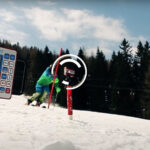 I saw a very different Mikaela Shiffrin win (in a tie with Anna Fenninger) the first World Cup race of the 2014-15 season and claim her first World Cup GS victory. What I saw in Mikaela’s skiing was not good.
I saw a very different Mikaela Shiffrin win (in a tie with Anna Fenninger) the first World Cup race of the 2014-15 season and claim her first World Cup GS victory. What I saw in Mikaela’s skiing was not good.
“What?,” you say, “She just won a World Cup race and you’re saying that it wasn’t good skiing.” Well, yes, but give me a little space to explain myself.
I have seen Mikaela train many times since her first year at Burke Mountain Academy when she was 13 years old. I also saw her train for several days in Loveland, CO last May while I was there working with another athlete. One thing that I have always been amazed at is how rock solid she is. I can’t remember her ever skiing out of a course (though I assume she has). Not only that, but I have rarely seen her even out of balance or make a major mistake (which, again, I assume she has).
Mikaela is obviously rip-roaring fast as a slalom skier, having won two World Cup globes in the discipline and Olympic and World Championship gold medals. At the same time, I think that, by her incredibly high standards, she was only doing, yes, you hear me say it again, “good skiing.”
Here is where the new and improved Mikaela arrived in Soelden. What I saw in her two GS runs was not good skiing, but fast skiing. She was stivoting all over the place, off balance constantly, and on the edge the entire run. It reminded me of what I consider to be one of the great GS races of all time, namely, Ted Ligety’s gold medal performance at the 2013 World Championships in Schladming, another two runs of stivoting and reckless abandon.
This shift in Mikaela’s skiing is why I think that, though she has dominated in slalom for the last two years, she may be even more dominant in slalom this winter if she makes the same transition in her GS from good skiing to fast skiing in slalom as well.
Good Skiing
This difference between good skiing and fast skiing is a huge distinction for me and one that I work with racers on constantly. Over my many years in ski racing, first as a racer and then as a sport psych consultant, I have seen many good skiers. They were technically and tactically sound and made really nice turns. These good skiers were solid and consistent. Only one problem. They weren’t usually on the podium. Why? Because they were more focused on skiing well than skiing fast.
Here’s the problem. Good skiing doesn’t necessarily translate into fast skiing. I’m on the hill with young racers constantly each winter and summer and I see a misguided emphasis on good skiing among both racers and coaches. Of course, solid technique and tactics are necessary to ski fast, but they are not sufficient. And, the last I checked, they don’t give style points in ski racing. All that matters is the time that accumulates between the start and the finish. You can have a beautiful run and be slow, and you can have a truly ugly run and be fast. In fact, thinking back to my racing days, the races in which I thought I had skied great were inevitably slow and the races where I hacked my way down the course were almost always fast.
Here’s how I think about good skiing:
- Stable
- Balanced
- In control
- Clean turns
- Comfortable
- Predictable
- Programmed
- Safe
- Smooth
- NOT FAST!
Fast Skiing
Fast skiers have a very different approach to racing. Good skiers focus on going around the gates during a race run. But fast skiers aren’t thinking about going around the gates. The Teds and Mikaelas of the World Cup are focused only on getting from the start to the finish as fast as they can. Of course, they do go around the gates because those are the rules, but that’s not what’s on their minds.
Here’s how I think about fast skiing:
- On the edge
- Ragged
- Mistake ridden
- Improvisational
- Risky
- Uncomfortable
- FAST!
You look at Ted’s skiing year in and year out, and Mikaela’s performance in Soelden and you see many mistakes in which they lose time. But the reason they are making these mistakes is because they are going so fast! Any time that they lose from throwing down a massive stivot is more than offset by the time they gained before the stivot or mistake because they were going so darned fast.
Here’s the problem for many young racers. Fast skiing is inherently risky. Yes, the only way to ski fast is take massive risks. The downside is that, by the very nature of risks, they may not work out, resulting in a DNF or a massive mistake and a slow time.
Also, there is only one way to find out how fast you can ski, namely, by crossing the threshold and perhaps crashing and burning. Good skiing doesn’t allow that to happen; only fast skiing does. What makes the great ones great is their ability to find that threshold and then ski just inside of it consistently. Finding and staying just inside that line is a skill that takes practice and the willingness to fail and to get really uncomfortable until that which was uncomfortable becomes comfortable.
Yes, of course, continue to improve your technique and tactics. But don’t stop there. Once you’re feeling solid in those two areas and doing good skiing, set them aside and turn your attention to what ultimately matters most—fast skiing!—and let ‘er rip.
Over the winter, I will share with you many ways to make this shift from good skiing to fast skiing. But it starts with knowing the difference and changing your perspective and goal of what you want to do on skis which, for me, is to ski fast!
All my best to you racers, coaches, and parents this coming winter. Have fun and ski fast!





